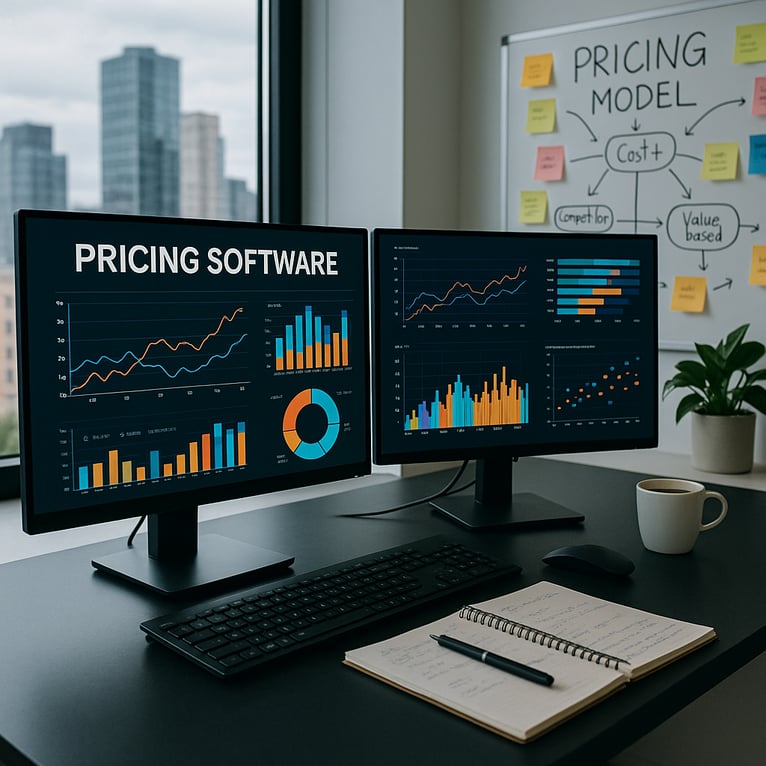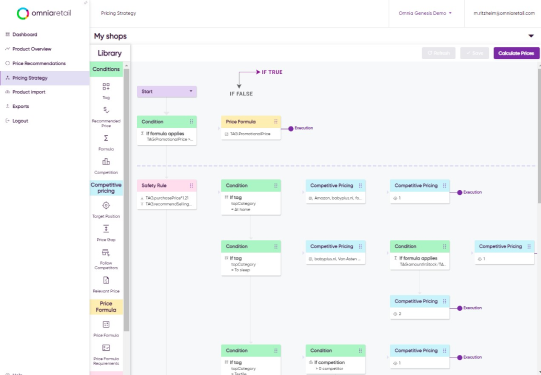Black Friday is one of the most important events in the e-commerce calendar. It is a period when consumer spending surges and competition intensifies. For e-commerce retailers and D2C brands of all sizes, from enterprise to SMB, early and data-driven Black Friday pricing preparation is essential to protect margins and capture market share.
With advanced tools like Omnia pricing software, retailers can automate price monitoring and market monitoring, apply sophisticated rules, and react to real-time changes in the market. This combination of insight and execution ensures that your pricing strategies deliver maximum impact during the most competitive sales period of the year.
Black Friday Pricing Preparation: What Last Year's Data Reveals
Our analysis of six weeks of pricing data, covering around 60,000 products across the German and Dutch markets in categories such as consumer electronics, sporting goods, and health & beauty, revealed several important patterns that can guide preparation this year.
1. Early preparation is key
Prices often start trending downward more than a week, sometimes two weeks, before Black Friday. Retailers who wait until the last minute risk missing early promotional opportunities. Cyber Monday also plays a major role across industries, with prices typically rebounding only after this extended sales period ends.
2. Industry-specific pricing behaviours
Not all categories follow the same pattern:
- Consumer electronics: Gradual, steady price decreases start as early as three weeks before Black Friday.
- Health & beauty: Less aggressive discounts until closer to the event, showing a preference for targeted promotions.
- Sporting goods: Steeper price drops, often in two stages, with an initial discount followed by deeper cuts just before Black Friday.

3. Lower-priced products see more and deeper discounts
Products in lower price ranges (e.g., 0–50 EUR) are discounted more frequently and with higher percentage reductions. This strategy allows retailers to advertise significant savings while keeping the absolute price change relatively low.

The chart shows discount activity normalised by price range. Each bar represents the share of discounted products within that specific price range. For example, in the 0–50 euro range, around 10% of consumer electronics products are discounted.
Looking at the patterns, some interesting differences emerge:
- Consumer electronics discounts appear to shift slightly toward mid-range products rather than entry-level or premium items.
- Health & beauty continues to favor discounts in the lower ranges, while higher-priced products are less likely to be included.
- Sporting goods display a flatter distribution, but with an unusual spike in the 300+ euro range. This is largely because such high-priced products are less common in this category, making the discounts more visible.
These differences highlight how each industry follows its own logic during Black Friday. While general patterns can guide preparation, only a deeper dive into your sector’s specific behavior will uncover the insights that truly help refine and adapt your pricing strategy.
4. Competitiveness influences discount elasticity
More competitive products often see smaller discounts, while niche items may benefit from steeper price drops. Lower margins on high-competition products leave less room for aggressive discounts without triggering a price war.
Strategic Preparation: Turning Insights into Action
Understanding market dynamics is only the first step. The next is to translate insights into a powerful pricing strategy using tools like Omnia pricing software.
1. Comprehensive market and internal analysis
Before setting any prices, a thorough analysis is critical:
- Identify discount opportunities: Use dashboards displaying 'Cheapest Unit Price' and 'Average Unit Price' to categorize products by market positioning. Higher-priced products may benefit from aggressive discounts, while already competitive items require smaller adjustments.
- Assess competitive landscape: Track metrics such as 'Offer counts' and 'Offer counts below selling price' to understand competitor activity. High counts suggest a crowded market, while low counts indicate niche products.
- Track performance over time: Monitor selling prices, market prices, and units sold in the run-up to Black Friday. Historical trends help predict promotion impact.
- Integrate internal data: Combine market insights with internal information like stock levels, product lifecycle, and popularity metrics. Define your primary goal for Black Friday -revenue, margin, or stock clearance- to guide strategic decisions.
2. Proactive pricing strategy implementation
Omnia pricing software enables retailers to prepare and apply Black Friday pricing strategies well in advance, giving you the flexibility to focus on other critical tasks as the campaign approaches.
- Version control for strategies: Test and save distinct pricing trees specifically for Black Friday. If you plan to run a modified or entirely different setup, you can build and test a separate strategy tree, save it for later, and then revert to your standard strategy once the campaign ends. This ensures your Black Friday pricing is fully prepared ahead of time, removing the need for stressful last-minute changes.

- On-the-Fly Price Calculation Results: Quickly test how your strategy would perform under real market conditions. This feature allows you to see the price calculations in action, understand the expected outcome, and refine your rules before activating them for the campaign.
- Conditional pricing with 'If Date Tag': Apply promotional pricing to a specific product list only during the Black Friday period. For example, set a rule to match the cheapest market price or apply a targeted discount dynamically. This ensures your strategy adapts to market dynamics while staying controlled and campaign-specific.
3. Maintaining control with precision
- Approval workflow: Review price recommendations before updating your ERP or website. This prevents margin erosion and ensures responsiveness to competitor changes.

- The approval flow in Omnia plays a crucial role in Black Friday pricing strategy by giving retailers and brands control over automated price recommendations. Based on your predefined strategy, recommended prices are calculated using market conditions, such as the cheapest competitor price or your minimum allowed price. The approval threshold allows you to review these recommendations for key products, quickly assess the price calculation rationale, and even view historical price trends over the past 90 days to make informed decisions. You can accept, reject, or manually modify individual price recommendations, or manage multiple products in bulk. This ensures your pricing strategy remains competitive and dynamic during the high-pressure Black Friday period while protecting margins and avoiding unintended price wars.
4. Evaluating your Black Friday impact
- Performance dashboards: Track metrics like revenue, margin, price ratio, and units sold. Filter data by product, category, or time frame to gain detailed insights.
- Comparative analysis: Compare Black Friday results against normal weeks to evaluate strategy effectiveness and identify opportunities for optimization in future campaigns.
For a full dive into Black Friday pricing strategies and real-life examples, see the full webinar recording with PDF slides.
/Omnia-ScreenAnimation_V01.gif)
Conclusion
Black Friday is a highly competitive and complex period, but with a strategic, data-driven approach, e-commerce retailers can achieve significant results. Early preparation, thorough market understanding, and adaptable pricing tools are critical for success. By combining internal insights with real-time market data, proactively setting up pricing strategies, maintaining control through approval workflows, and evaluating performance carefully, retailers can turn insights into tangible growth.
Ready to elevate your Black Friday pricing preparation? Discover how Omnia pricing software can help you master pricing strategies, automate price monitoring, and stay ahead with market monitoring. For detailed examples and actionable tips, check out the full webinar recording with PDF slides.
Frequently Asked Questions
What is the best way to prepare pricing strategies for Black Friday?
Early, data-driven preparation is essential. Analyze historical trends, monitor competitor prices, identify discount opportunities, and define clear goals. Using advanced tools like Omnia pricing software helps automate and optimize these strategies.
How can price monitoring improve Black Friday performance?
Continuous price monitoring ensures products remain competitive in real time. Retailers can respond immediately to market changes, avoid margin erosion, and maximize revenue with dynamic pricing adjustments.
Why should retailers use Omnia pricing software during Black Friday?
Omnia allows retailers to implement flexible, automated pricing strategies, perform detailed market monitoring, and maintain control with approval workflows. This ensures maximum impact during Black Friday while protecting margins and staying ahead of competitors.



.png?height=766&name=Untitled%20design%20(21).png)

